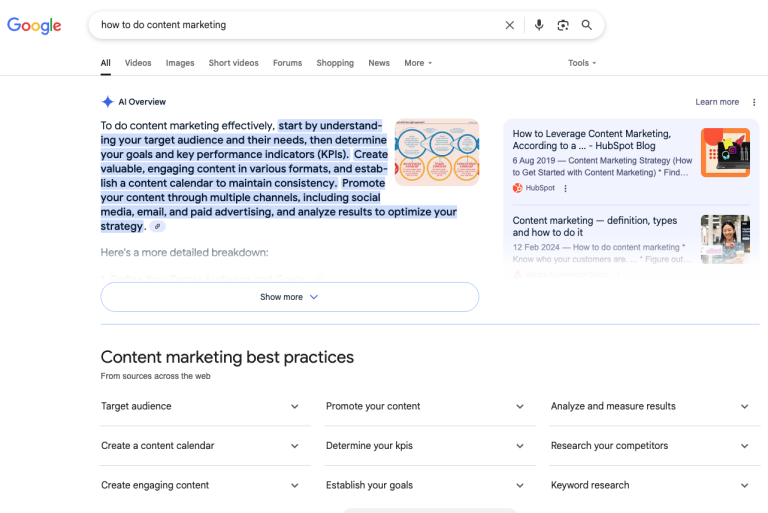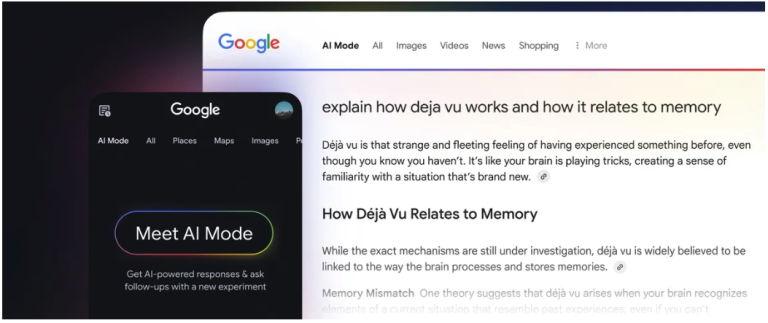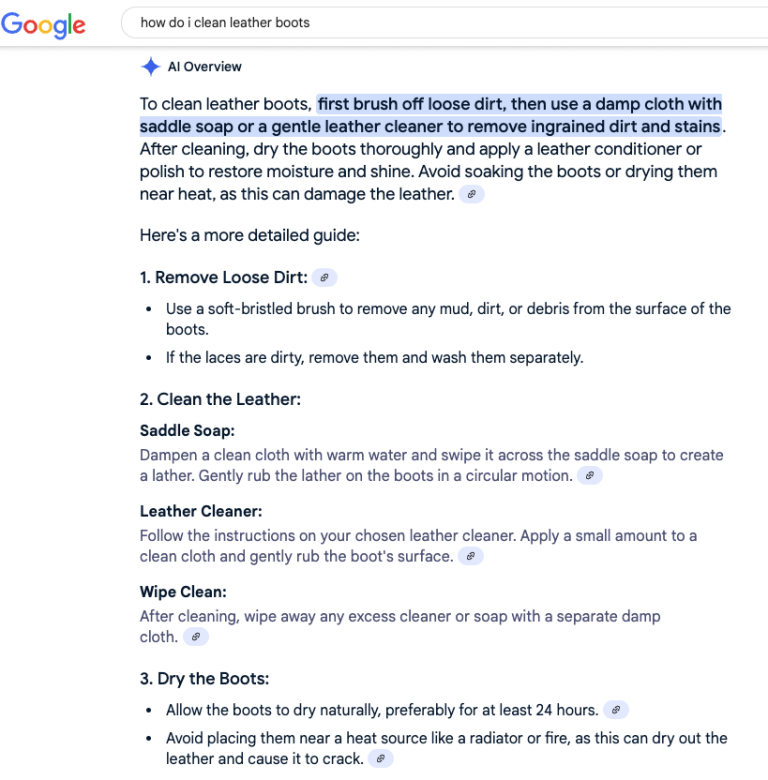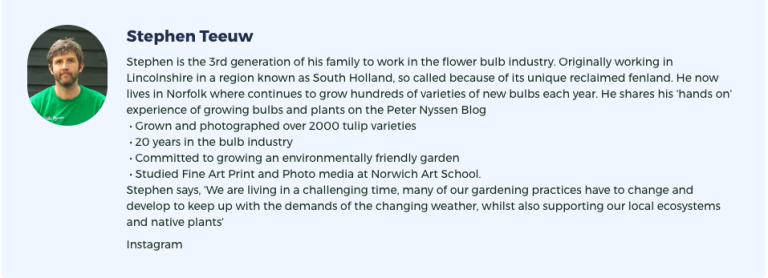In the age of AI-driven search, SEO for eCommerce is undergoing a dramatic evolution. Search engines are increasingly answering queries directly on the results page, leading to “zero-click” searches where users get what they need without ever visiting a website. At first glance, this trend might alarm eCommerce businesses – if fewer people click through, does SEO still matter? The resounding answer is yes.
Inspired by our recent eCommerce roundtable, this whitepaper distils how brands can adapt and thrive in a search landscape dominated by AI-generated answers. We’ll explore the impact of AI on organic visibility, strategies for AI-first content, and how to realign your SEO metrics and tactics for long-term success. The goal is to provide practical, actionable insights – in plain English – to help you futureproof your SEO and keep your brand visible and persuasive, even when clicks are scarce.

AI is transforming Google from a search engine into an “answer engine.” Take Google’s new AI Overviews: AI-generated summary answers appear above the regular search results. Instead of a single snippet from one website, the AI Overview consolidates information from multiple sources into one unified answer.
The result?
Users often find what they need without clicking any further. Nearly 60% of Google searches in 2024 ended without a click – the user either got their answer on the SERP or refined their query without visiting a site. This zero-click trend isn’t just theoretical; it’s the new normal in search user behaviour.
From an organic visibility standpoint, these changes present a double-edged sword. On one hand, informational queries (like “How do I improve my Magento site speed?”) are most likely to trigger AI-generated answers, which can siphon off traffic that would have gone to blog posts or guides.
On the other hand, transactional and commercial queries (like “Buy Adidas running shoes UK” or product searches) do not generally show AI overviews – yet. But in practice, this means your high-intent shoppers are still seeing the traditional link-filled SERPs for now, not AI summaries diverting them away from your product pages. But recent changes in the US, such as Google’s AI mode, may change this soon in the UK as well. AI mode will allow users to use AI to shop. The tool will for example let them upload an image and Google AI Mode will provide them with the best option.

Google currently reserves AI answers mostly for question-like searches and “day-to-day” informational queries, not product purchases. So, while your how-to guides and informational content might see fewer clicks, your category and product pages can still attract shoppers as usual.
That said, AI-driven results are growing fast. By March 2025, over 13% of all Google queries showed an AI Overview, more than double the share from just two months earlier. Google is testing and expanding these features. As AI results become more common, organic engagement metrics are shifting. Marketers have noticed that as Google gives more answers directly, organic traffic may plateau or dip even if your rankings remain high. But no clicks doesn’t mean no opportunity. It simply means we have to redefine what it means to “rank” and how we engage users.
Key takeaway: Rather than viewing AI answers as an SEO apocalypse, see them as a call to action. Your content can still appear within those answers, and your brand can still make an impression even if no immediate click occurs. The challenge is ensuring your site is the trusted source that Google’s AI pulls information from, effectively earning you visibility without a click. In the sections ahead, we’ll dive into how to do just that, from crafting AI-ready content to measuring success in new ways.
The classic SEO strategy is to create content for humans first, search engines second. And this hasn’t changed but in the AI age, we need content that serves both search engines and AI. An AI content strategy means anticipating how AI systems read and use your content, and leveraging AI tools to scale up your content creation – all while maintaining quality and authenticity.
AI can be a game-changer for producing content at scale. For example, eCommerce teams using the likes of Magento, Shopify or WooCommerce (WordPress) can use AI to generate initial drafts of product descriptions, blog outlines, or FAQs in a fraction of the time it takes to write from scratch. In one case, an online retailer used AI to generate over 25,000 product descriptions, boosting SEO visibility and even reducing bounce rates by 18%. Those are impressive gains in efficiency. But the results are yet to be proven.
However, AI is best used as a writing assistant, not a fully autonomous writer. Always review and edit AI-generated text to ensure accuracy, add fresh insights, and infuse your brand voice. This human touch is vital – Google’s guidance makes it clear that experience and expertise (part of E-E-A-T) are still critical for content quality, no matter how it’s produced. In practice, that means supplementing AI drafts with real examples, case studies, and advice drawn from your team’s knowledge. For instance, if you run a Magento fashion store, you might use AI to draft a guide on “choosing the right formal shoes,” but you should enrich it with your in-house experts’ tips on fit and styling. The result is content that’s scalable yet unique and trustworthy.
With Google often pulling answers directly onto the SERP, it’s important to format some of your content to answer common questions clearly and concisely. This could mean adding an FAQ section to your product pages or writing blog posts in a Q&A style. You can use plugins or content blocks to create FAQ schemas that search engines love.
Ensure your product Q&As or knowledge base content is crawlable and well-organised. When you pose a question as a heading (e.g., “How do I clean leather boots?”) and immediately answer it, you increase the chances of Google featuring that snippet – or even using it as part of an AI overview.

Aim to answer the question in the first 1-2 sentences, then expand with detail. This is the same way a journalism article is written. Summarise the key information at the top and then expand for those with more time or interest to read in further detail. This way, even if Google only displays a short answer, the user still sees your site providing the value, reinforcing your brand’s authority.
An AI-first strategy isn’t only about written content – it’s also about how it’s presented. Implementing structured data (schema) helps search engines and their AI understand your content context. For eCommerce, make sure you use the Product schema (for product name, price, availability, reviews) and the FAQ schema on relevant pages.

This not only can win you rich snippets (star ratings, price info in SERPs) but also feeds Google’s knowledge graph, which underpins AI answers. In a world where AI might read out an answer to a user’s voice query, having well-structured data increases the odds that the answer comes from your site. Don’t forget the basics, too: meta titles and descriptions may not directly influence rankings, but they act as your “ad copy” on the SERP when users do see your link. Craft them to be compelling and to set proper expectations, which can improve clicks and reduce bounce rates from those who do visit.
AI in search is very intent-savvy – Google’s generative search tries especially hard to address informational intents in one go. So, revisit your keyword research with an eye on intent. For eCommerce brands, you likely have content targeting various funnel stages: product pages for transactional intent, category pages for commercial intent (browsing options), and blog/guide pages for informational intent. An AI-first approach means ensuring each piece of content fully satisfies the intent it targets.
If you have a blog on your site, tailor each article to a specific question or problem your customers have, and answer it thoroughly (yet succinctly). If you sell power tools online, an informational piece like “How to choose a cordless drill for DIY projects” should anticipate all sub-questions a DIY shopper might ask, effectively pre-empting the need for another search. This depth and relevance make it more likely that Google’s AI will trust and feature your content. Even on product pages, think beyond just specs: include guides, size charts, comparisons or even brief “how to use” sections. Not only do these additions help shoppers, they also serve up bite-sized facts that an AI answer bot might pick out.
AI algorithms love up-to-date information. They draw from the latest data on the web. For eCommerce, this means maintaining current content – update your blog posts regularly, refresh stats or examples, and ensure discontinued products are noted or redirected. Use tools (or AI itself) to monitor emerging questions in your niche. For example, if there’s a spike in searches for “best garden furniture for summer” or there’s a new product release, consider quickly creating content around it. Being among the first to answer a new question not only can earn you a featured snippet but could also land your answer in an AI overview before competitors have even noticed the trend. In short, blend AI efficiency with editorial agility: let AI help you produce and update content quickly, so you can cover more ground and stay relevant.
Automation and AI can supercharge your content production, but SEO is not an assembly line – especially for businesses that need to stand out. The risk of leaning too heavily on AI tools is ending up with cookie-cutter content that sounds generic. The antidote is to deliberately infuse brand voice, creative strategy and a unique take into everything you do.
Think of AI as your junior copywriter. It can crank out a decent first draft or generate 50 headline ideas in a flash. But it’s your job to refine that output. Ensure the tone, wording, and examples align with your brand’s personality. If your Magento fashion store’s brand voice is witty and trend-conscious, an AI draft describing a summer dress might be factual and bland – you’d tweak it to add flair and maybe a pop-culture reference that resonates with your audience. Consistency in voice builds trust and recognition. There are even AI tools that let you “train” a custom model on your brand voice, but a simpler method is to create a style guide (preferred vocabulary, tone dos and don’ts) and enforce it during content editing.
Remember, everyone has access to the same AI tools, so the differentiator becomes the personal touch you add post-generation. This is where your team’s creativity and domain knowledge shine.
It’s tempting to let AI spit out dozens of blog posts to try and capture every keyword. But quantity is not a guarantee of quality or rankings – in fact, Google’s Helpful Content system can demote sites that churn out fluff. Instead, use AI to improve quality and relevance: for example, generate multiple angles for a blog topic and pick the most original one, or use it to analyse search results and identify content gaps your piece can fill.
The goal is creative SEO thinking: find unique value that your content can provide. That might mean conducting a small experiment or survey to gather fresh data for a blog post (which AI cannot do for you), or writing a genuinely insightful opinion piece about your industry. Such content earns backlinks, social shares, and citations – things that AI-generated drivel won’t achieve. If you do leverage AI for idea generation, always evaluate ideas against your users’ needs and your brand’s expertise. Does this piece help my customers? Does it say something new or better? If not, rethink it.
In the AI era, expertise is your ace card. AI tools remix content from the web; they don’t have first-hand experience with your products or customers. So double down on showcasing real expertise. That could be as simple as including quotes or tips from your in-house specialists or CEO in your content. In your blog, consider author bylines with bios, profile images and social links that establish credibility (“Jane Doe, 10+ years in fitness retail”).

If you’re an SME without a household brand name, building this personal and brand authority is crucial. Not only will it make your content more compelling to readers, but it also aligns with Google’s focus on E-E-A-T (Experience, Expertise, Authority, Trustworthiness). Remember, “Efficiency should never come at the cost of credibility”. For example, if you use AI to draft a health supplement description, ensure it’s reviewed by someone with nutritional expertise and add their stamp of approval. The content should read as uniquely yours, not a Wikipedia rehash.
Beyond content creation, think creatively about how to capture traffic and engagement in an AI-influenced world. If fewer people click through on general queries, maybe you can pull them in through interactive or rich results. Consider implementing features like interactive calculators, quizzes, or tools on your site (for example, a “find your perfect product” quiz).
While an AI answer might tell someone “the best running shoe depends on your gait and terrain,” an interactive tool on your site can engage them to find their best shoe – something an AI answer box cannot do. Promote such unique resources in your meta descriptions or schema, so it’s clear in the SERP that clicking your link offers something extra.
Another creative angle is using AI-generated video tools like Google’s Veo. Businesses can now easily create engaging explainer videos, product animations, or quick demos without high production costs or expertise. While AI won’t replace human creativity or your unique brand voice, it drastically lowers barriers, helping diversify content formats quickly and effectively. Embedding these videos in product pages or blogs can boost time-on-site and improve SEO engagement metrics, providing fresh discovery channels via YouTube and social media platforms that remain beyond the reach of zero-click AI summaries for now.

In short, use AI to work smarter and faster, but always review through the lens of your brand’s character and your audience’s genuine needs. The businesses that strike this balance will produce content that’s both efficient and effective, at scale.
When searchers behave differently, we have to measure success differently. If you’re still only looking at rankings and organic traffic, you’re missing the bigger picture of SEO value in the AI age. It’s time to expand what counts as a win.
Traditional SEO was obsessed with a “#1 ranking” for a keyword. But if a search result page is filled with AI answers, maps, carousels, etc., a #1 organic listing now might appear far below and only get a few clicks.
Start tracking metrics like Search Impressions and SERP visibility. Google Search Console can show you how often your site appears for queries (even if not clicked). Are you being featured as an authority source in AI summaries or answer boxes?
Some new tools and SEO platforms are beginning to report on “answer visibility” – essentially, whether your content was present on the SERP even without a click. For instance, if your blog post is referenced as one of the sources in Google’s AI Overview (Google has been testing source links with their summaries), that’s a visibility win. While it’s tricky to quantify fully, keep an eye on any available metrics or anecdotal evidence of your content being cited or highlighted on SERPs. The ultimate goal is to be seen, even if not clicked immediately.
Rather than mourning a drop in raw organic visits, focus on what the visitors who do click are doing. Are they highly engaged, and are they converting? Track engagement metrics like time on site, pages per session, scroll depth, and video plays. If AI-driven results are skimming off the casual info-seekers, the users still clicking through to your site may be those with deeper intent.
For example, a user who clicks through to your Magento store after an AI blurb answers a general question might be further along in the purchase journey. Look at your bounce rates and conversion rates from organic traffic – you may find that even if sessions drop, the percentage of those visitors who add to cart or fill out an enquiry form goes up. That’s a positive trade-off. It also hints that your content is attracting the right people (those who need more than a quick answer).
In your reports, consider highlighting conversion per 1,000 visitors or similar metrics that show efficiency of traffic, not just volume.
Industry experts suggest tracking some non-traditional SEO KPIs to gauge success now. For example, Branded search volume – if fewer people click on your informational content, they might still register your brand name and search for it later. An uptick in people Googling your brand or typing your URL directly is a strong signal that your content made an impression. Likewise, consider monitoring how often your brand or content is mentioned on social media or forums (brand sentiment), as well as if it’s being picked up as a reference by others (for instance, another site linking to your helpful guide because it was authoritative). Another emerging KPI is “on-SERP engagement” – for example, if you have a Google Business Profile (for a local storefront), how many users clicked to call or get directions without visiting your site?
These interactions matter to businesses like yours and can be influenced by your SEO work (optimising your profile, getting good reviews, etc.). Essentially, think of SEO not just as driving website traffic, but as influencing the entire digital journey of a customer. It’s getting harder and harder to silo the different areas of digital marketing. If a user reads your answer in an AI box today and signs up for your newsletter tomorrow, that’s still an SEO-driven win – even if Google Analytics didn’t count it as an organic session.
Zero-click searches force us to grapple with the reality that not all value is captured in last-click attribution. SEO might start the journey that another channel finishes. For example, a user finds your site via a Google AI summary, doesn’t click, but later sees your retargeting ad or finds you on social media and eventually buys. It pays to take a holistic view of marketing metrics. Use tools or techniques like attribution modelling or simply customer surveys (“How did you hear about us?”) to capture those indirect influences. You might discover your SEO content is frequently mentioned by customers as a reason they trusted your brand. Internally, champion metrics like conversion assists for SEO, where an organic visit was one touchpoint of a converting user’s path, even if not the last touch. This reinforces the idea that SEO builds brand equity and demand that materialises across channels over time.
In summary, broaden what you celebrate. A lower click-through rate (CTR) on a query might be fine if your content still got in front of the user and fulfilled its purpose. Track how SEO contributes to outcomes (leads, sales, brand growth), not just inputs (clicks, ranks). By doing so, you’ll get a clearer picture of SEO’s true ROI in the AI age.
Search is changing at breakneck speed, and businesses need to be nimble without losing sight of the bigger picture. The best approach is a balanced one: secure some quick wins to stay afloat today, while investing in sustainable SEO strategies that will pay dividends tomorrow.
These are optimisations and tactics you can implement in weeks, with immediate impact on visibility or conversions. For instance:
These quick wins help you adapt rapidly to the current environment, fixing leaks and capturing low-hanging fruit. They’re especially useful if you’ve seen a traffic dip – a way to claw back some visibility.
While you work on the above, chart your long-term course. SEO has always been a long game, and that hasn’t changed, even if the rules are shifting. Key long-term initiatives include:
It’s not either/or – you need both quick wins and a strategic roadmap. One useful approach is to adopt an 80/20 rule: devote perhaps 20% of your SEO efforts to experimental or reactive tactics (trying out a new AI SEO tool, hopping on a trending topic, etc.), and 80% to foundational work that aligns with your long-term goals. But also stay flexible; if a major algorithm change or AI update occurs (which is likely in this fast-changing environment), be ready to pivot. The advantage SMEs have is agility – you can often implement changes faster than a big enterprise. Use that to your benefit, but never lose sight of the fundamentals. Good content, solid site architecture, and focus on user intent will remain constants even as the SEO playing field is transformed by AI.
The AI age of search is not the end for SEO – it’s a call to evolve. As Google and other engines strive to answer everything instantly, the role of SEO shifts from just driving clicks to shaping presence and influence across the broader search landscape. For Magento and WordPress site owners, the path forward is clear: double down on understanding user intent and be proactive in adapting. If you create genuinely helpful, targeted content (with a little AI assistance) and ensure your brand is visible wherever answers are found, you’ll find that zero-click searches are no problem at all.
In practical terms, that means continuing to serve your users better than anyone else. Align your content with what customers truly seek in their moments of need. Be it a quick fact or a deep dive, make sure you’re delivering value across the buyer’s journey for all intents; sometimes these are even before a click ever happens. Track the metrics that matter to this new reality, like engagement and conversions, rather than obsessing over the old pageview count. And keep experimenting: the search landscape will keep changing, and the businesses that thrive will be those who embrace change early and often.
To conclude with a reassurance: SEO isn’t dying, it’s maturing. The AI-driven search environment is weeding out shallow tactics and rewarding those who focus on meaningful user experiences. By following the strategies outlined in this paper – from AI-forward content creation to rethinking success metrics – you’ll not only safeguard your organic performance but also create a stronger, more resilient digital presence.
In the AI age, the winners are those who combine the best of technology with the best of human insight. So go ahead: adapt, experiment, and lead with your expertise. The clicks you earn may be fewer, but they will count more than ever.
No clicks? No problem. With the right approach, your SEO will continue to drive growth in ways that truly matter.
